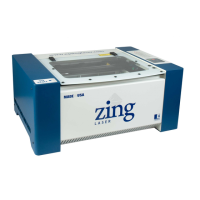Section 13: Material Engraving Techniques
177
consuming and most engravers do not want to spend the time and effort necessary to
turn this into an acceptable product.
Note - Always ask before lasering painted brass if you don’t know what the substrate
is! If you are unsure if the piece that you have is brass-coated steel or brass, you can
test the material with a magnet. A magnet will stick readily to brass-coated steel, but
since solid brass is not magnetic, a magnet will fall helplessly away from solid brass.
Painted Brass Engraving Techniques
Engrave painted brass at high speed and low power. It takes very little power to
remove the paint coating and too much power will melt the paint and distort the
image. If you are producing engraving that appears to be “fat” or has a balloon
appearance to it, you are probably using too much power. Reducing the power will
bring back the nice sharp images that are normally produced with painted brass.
Note - Use caution when trying to engrave brass coated pens. Many pens have a very
hard epoxy paint that is completely unacceptable for CO2 laser engraving. You
should only use pens that you have experimented with or that are specifically
designed for CO2 laser engraving. Be aware that there are many pens that can be
laser engraved with a YAG laser but these pens are usually not compatible with the
CO2 laser that you are using.
Some pens are “almost” CO2 laser engravable. If you engrave through the paint and
there is a slight shadow remaining, try to clean the engraved area with alcohol or
lacquer thinner. Depending on the paint, there is a good chance that the shadow will
disappear and an excellent engraving result achieved.
Use caution when trying to engrave blue painted brass. Blue paints contain very
aggressive pigments that penetrate the metal surface and it can be extremely difficult
to remove all of the blue color, but again, try alcohol or lacquer thinner to remove the
shadow.

